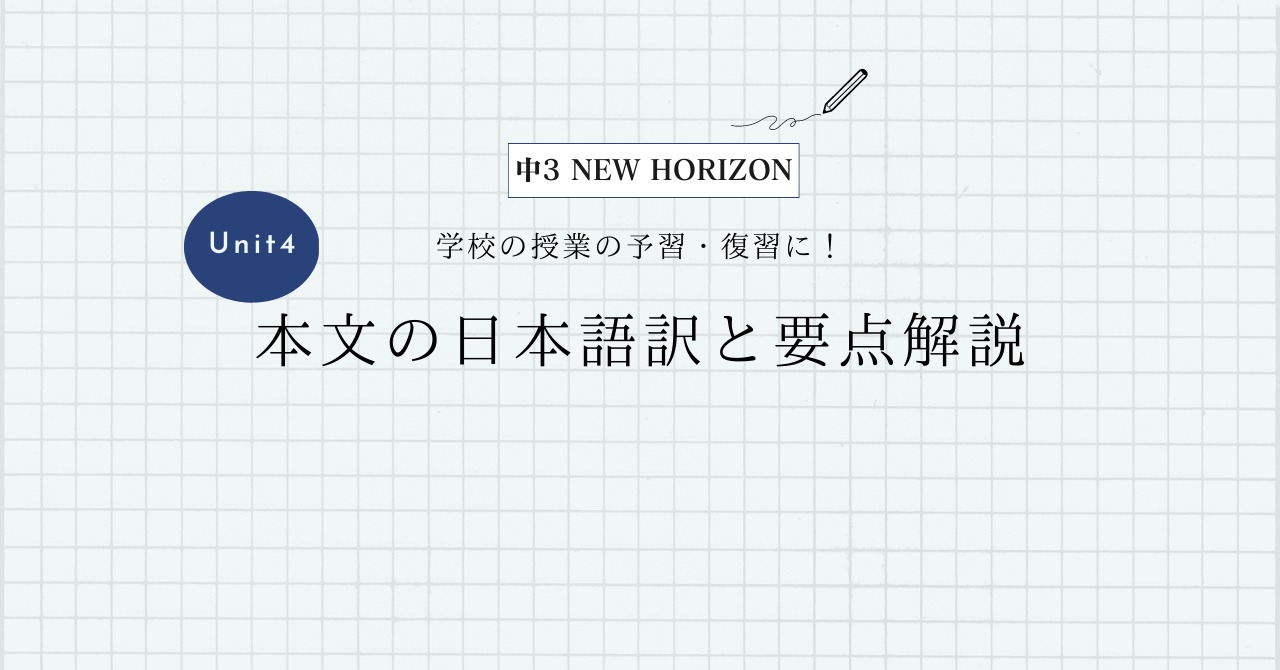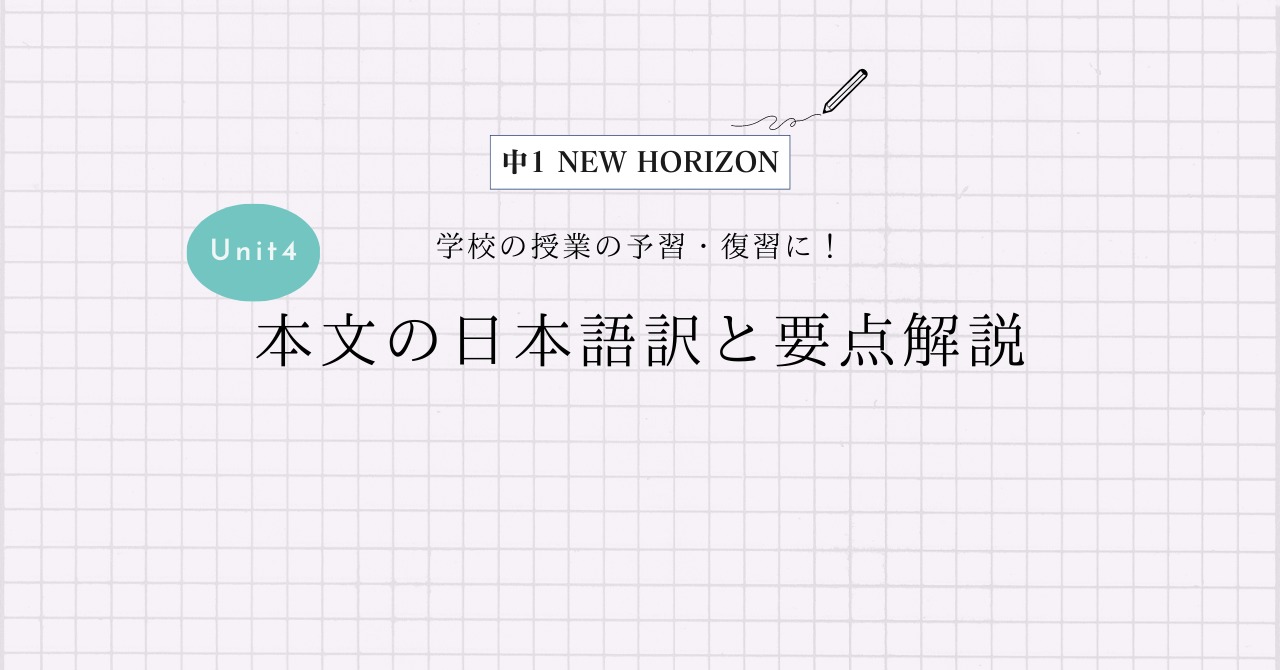東京書籍 中学3年生 NEW HORIZON(ニューホライズン) Unit4 Read & Think2の本文の日本語訳と重要箇所の解説です。
Unit4-1,4-2とRead & Think1の解説はこちらからご覧ください。
>中3NEW HORIZON Unit4 Scene1 本文和訳
>中3NEW HORIZON Unit4 Scene2 本文和訳
>中3NEW HORIZON Unit4 Read & Think1 本文和訳
- Unit4 Read & Think2 本文と日本語訳
- Unit4 Read & Think2 重要事項の解説
- What did Wakaba City have yesterday?
- Every year, more and more foreign people are coming to live in Japan.
- The number of tourists visiting Japan is growing, too.
- Many of them don’t know what to do in an earthquake.
- It’s necessary for us to be prepared to help them.
- Wakaba City had an evacuation drill for foreign residents and visitors yesterday.
- In the drill, they experienced some simulations and learned how they can protect themselves.
- They followed instructions given in English and easy Japanese.
- The city handed out an evacuation map made by Wakaba Junior High School students.
- The map uses simple symbols and pictures.
- It shows people where they should go in a disaster.
- We interviewed some students at the school.
- One said, “We’re glad to help foreign people. It’s important for everyone to help each other and work together.”
- Yesterday was a good start.
- Everyone should be prepared.
- Unit4 Read & Think2 まとめ
Unit4 Read & Think2 本文と日本語訳
What did Wakaba City have yesterday?
「ワカバ町では昨日何がありましたか?」
Every year, more and more foreign people are coming to live in Japan.
「毎年,ますます多くの外国人が日本に住みに来ています。」
The number of tourists visiting Japan is growing, too.
「日本を訪れる観光客の数も増え続けています。」
Many of them don’t know what to do in an earthquake.
「彼らの多くは地震のときに何をすべきか分かっていません。」
It’s necessary for us to be prepared to help them.
「彼らを助ける準備をすることが私たちには必要です。」
Wakaba City had an evacuation drill for foreign residents and visitors yesterday.
「昨日,ワカバ町では外国人居住者と訪問者のための避難訓練がありました。」
In the drill, they experienced some simulations and learned how they can protect themselves.
「訓練で,彼らはいくつかのシミュレーションを体験して,どうすれば自分自身を守ることができるかを学びました。」
They followed instructions given in English and easy Japanese.
「彼らは英語と簡単な日本語でされる指示に従いました。」
The city handed out an evacuation map made by Wakaba Junior High School students.
「町はワカバ中学校の生徒によって作られた避難地図を配りました。」
The map uses simple symbols and pictures.
「その地図には簡単な記号と絵が使われています。」
It shows people where they should go in a disaster.
「そこには災害の時にどこに行くべきかが書かれています。」
We interviewed some students at the school.
「私たちは学校で何人かの生徒にインタビューしました。」
One said, “We’re glad to help foreign people. It’s important for everyone to help each other and work together.”
「ある人は『外国の方を助けられて嬉しいです。お互いに助け合い,一緒に働くことがみんなにとって重要です。』と言っていました。」
Yesterday was a good start.
「昨日は良いスタートを切れました。」
Everyone should be prepared.
「みんなが準備をするべきです。」

Unit4 Read & Think2 重要事項の解説
What did Wakaba City have yesterday?
“have”は「~がある」という意味でもよく使います。
この文を直訳すると「ワカバ町は昨日何を持っていましたか?」になり,綺麗な日本語にすると「ワカバ町では昨日何がありましたか?」となります。
Every year, more and more foreign people are coming to live in Japan.
“more and more”は「ますます多くの」という意味になります。“foreign”は「外国の」という形容詞です。
“come to 動詞の原形”は「~しに来る」という意味で,「不定詞の副詞的用法」になっていますよ。
また,この文では「現在進行形」が使われていますね。
The number of tourists visiting Japan is growing, too.
“the number of~”は「~の数」という意味になります。“tourist”は「観光客」という名詞です。
“visiting”は「現在分詞」になっていて,“visiting Japan”が直前の“tourists”を修飾しています。
“grow”は「成長する,増える」という動詞ですね。
“, too”は文末に付けて「~も」という意味になりますよ。
また,この文でも「現在進行形」が使われていますね。
Many of them don’t know what to do in an earthquake.
“them”は“tourists”を指しています。
“what to do”は「疑問詞+不定詞」の形になっていますね。
“earthquake”は「地震」という名詞になります。
It’s necessary for us to be prepared to help them.
この文は「It to構文」が使われていますね。
“necessary”は「必要な」という形容詞で,“be prepared to 動詞の原形”は「~する準備ができている」という表現になります。
“them”は“tourists”を指していますよ。
Wakaba City had an evacuation drill for foreign residents and visitors yesterday.
“evacuation”は「避難」,“drill”は「訓練」,“resident”は「居住者」という名詞です。
In the drill, they experienced some simulations and learned how they can protect themselves.
“they”は“foreign residents and visitors”を指していますよ。
“experience”は「を経験する,体験する」という動詞です。“simulation”は「シミュレーション,模擬実験」という名詞ですね。
また,この文では「間接疑問文」も使われていますね。
“protect”は「を守る」という動詞で,“themselves”は「彼ら自身」という代名詞になります。
They followed instructions given in English and easy Japanese.
“follow”は「に従う,付いていく」という動詞です。“instruction”は「指示,説明」という名詞ですね。
“given”は「過去分詞」になっていて,“given in English and easy Japanese”が直前の“instructions”を修飾しています。
The city handed out an evacuation map made by Wakaba Junior High School students.
“hand out”は「配る」という動詞です。
“made”は「過去分詞」になっていて,“made by Wakaba Junior High School students”が直前の“an evacuation map”を修飾しています。
The map uses simple symbols and pictures.
“simple”は「単純な,簡単な」という形容詞で,“symbol”は「記号,象徴」という名詞です。
この文は直訳すると「その地図は簡単な記号と絵を使っています。」となりますが,主語が「人」ではないので,「その地図には簡単な記号と絵が使われています。」と受動態で訳しました。
It shows people where they should go in a disaster.
“show 人 もの”で「人にものを示す,見せる」となって,“show もの to 人”でも同じ意味になります。
他には“teach”, “tell”, “give”などが同じ使い方をできるので必ず書き換えられるようにしておきましょう。
また,この文でも「間接疑問文」が使われていますね。“disaster”は「災害」という名詞です。
We interviewed some students at the school.
“interview”は「インタビューする,面接する」という動詞です。
One said, “We’re glad to help foreign people. It’s important for everyone to help each other and work together.”
“one”は「ある」くらいで訳してあげましょう。
“be glad to 動詞の原形”は「~して嬉しい」という意味になりますね。「不定詞の副詞的用法」が使われていますよ。
また,この文でも「It to構文」が使われていますね。
“each other”は「お互い」という重要表現です。必ず覚えておきましょう!
Yesterday was a good start.
“start”は「開始,スタート」という名詞で使われています。
今回は「スタートを切った」と訳しました。
Everyone should be prepared.
“should”は「~すべきだ,~のはずだ」という助動詞ですね。
Unit4 Read & Think2 まとめ
以上がUnit4 Read & Think2の日本語訳となります。
ここでは「分詞」や「疑問詞+不定詞」が使われていますね。しっかり理解していきましょう!
>中3NEW HORIZON Unit4 Scene1 本文和訳
>中3NEW HORIZON Unit4 Scene2 本文和訳
>中3NEW HORIZON Unit4 Read & Think1 本文和訳
何か分からない点や他に解説してほしい点があれば,お気軽にコメントしてください!




コメント